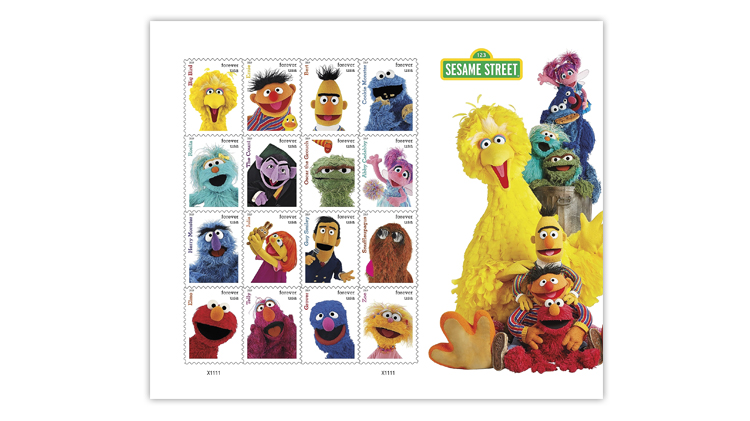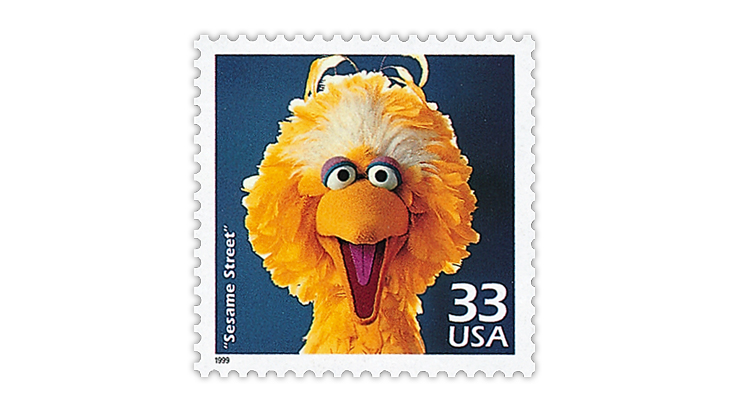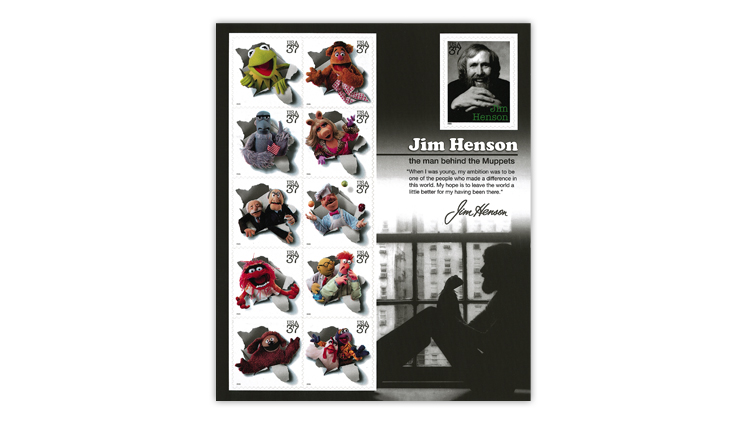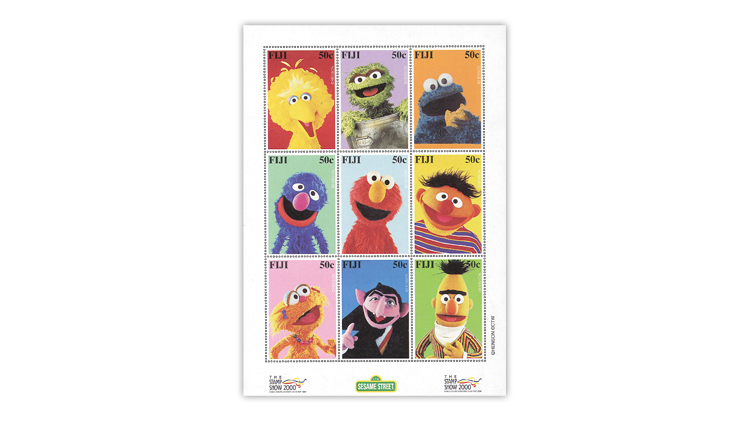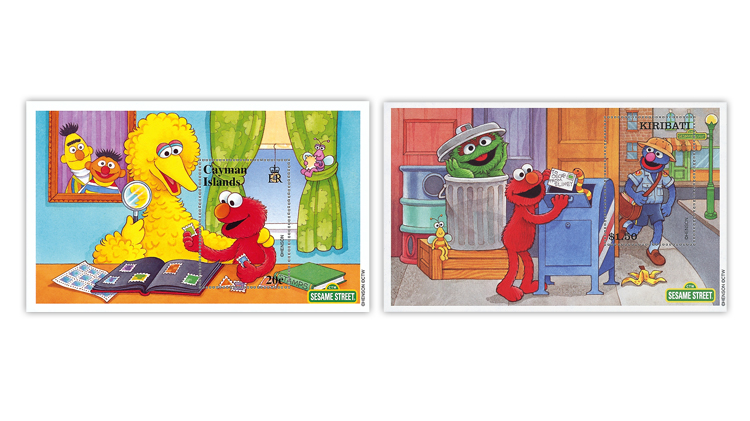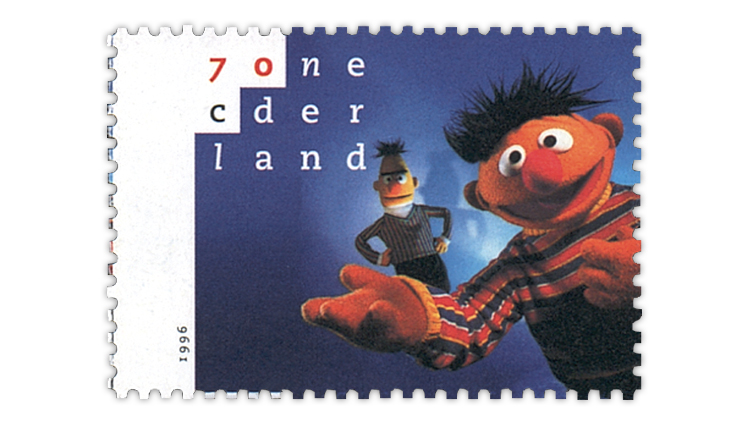US Stamps
Celebrating 50 years of ‘Sesame Street’
By Michael Baadke
It’s a mythical street in a magical place, with neighbors who care about each other and good friends who are ready to play and have fun.
Sesame Street has been part of the American television landscape for 50 years, entertaining preschool children and youngsters while also helping them learn. The United States Postal Service will pay tribute to the show and its cast of Muppet characters with a pane of 16 forever stamps that will be issued June 22.
Each self-adhesive nondenominated (55¢) stamp in the Sesame Street set highlights one prominent Muppet character from the show, with a photographic portrait against a white background.
Although human cast members have always been an important part of Sesame Street, they are not featured on any of the stamps or in the larger cast photo reproduced in the selvage along the right side of the pane.
The first-day ceremony for the Sesame Street stamps will take place in Detroit, Mich., at Lafayette Park, 1592 Antietam Ave., beginning at 9:30 a.m. Saturday, June 22.
The Postal Service advises that anyone wishing to attend the stamp ceremony should register in advance at www.usps.com/sesamestreet.
The ceremony will take place just before the Sesame Street Road Trip, which is described as an interactive family festival.
“The Sesame Street Road Trip is a timed entry event,” according to the Postal Service. “The First Day of Issue event will take place promptly at 9:30 am, please be sure to allow enough time to gain entry to the event space before the event begins.
“Additional instructions on how to gain entry to the Sesame Street Road Trip will be emailed to you before the event date. Please bring along a copy of your invitation or RSVP confirmation for admission.”
Although the stamp ceremony begins at 9:30 a.m., the Sesame Street Road Trip is scheduled from 10 a.m. to 3 p.m.
Online registration for the free Road Trip event can be found at www.sesamestreet.org/anniversary/road-trip-detroit.
The first episode of Sesame Street was broadcast Nov. 10, 1969, on NET, the National Educational Television network, which mostly morphed into PBS, the Public Broadcasting Service, the following year.
The program was shaped as a curriculum for preschool development, according to PBS. It mixes Muppet characters with human adults and children who live, work and play together on Sesame Street, an urban avenue with both residences and businesses.
“The phenomenon that changed the face of children’s television came about after co-founder Joan Ganz Cooney observed that children in underserved communities were at a disadvantage when it came to school preparedness,” according to the PBS website. “She assembled a team of educational advisors, researchers, and television producers to create a show that would directly impact children’s lives.”
The program uses skits and stories to help children understand basic concepts such as reading and writing, the alphabet and numbers, and it also looks at concepts such as the dynamics of friendships, expressing feelings and being considerate of others.
“While the series is designed to address all areas of children’s learning and development, the primary curricular focus changes every one or two seasons in order to meet preschoolers’ current critical needs,” according to PBS.
Youngsters and adults watching the program have grown familiar with the many Muppet characters that share their own learning experiences during the shows, often with a comedic undertone.
If there is a star among them, it is probably Big Bird, a towering yellow feathery creature with a curious and lovably childlike approach to just about everything. He appears in the very first stamp on the pane, in the upper left corner.
Big Bird was designed by puppet master Jim Henson (1936-90) and appeared on the first episode of Sesame Street. Big Bird’s biography on www.sesameworkshop.org explains that his favorite activities include “dancing, reading, and collecting different things.”
Big Bird is a good candidate to be a stamp collector, because he has appeared on one other U.S. stamp in the past.
In 1999, a pane of 15 stamps in the Celebrate the Century series was issued to commemorate the 1970s. One of the 33¢ stamps in this set shows a portrait of Big Bird with the caption “Sesame Street” (Scott 3189c)
Printed on the back of the 1999 stamp is: “Created for public TV by Children’s Television Workshop, ‘Sesame Street’ revolutionized children’s TV by combining entertainment and education. It helps children worldwide learn about letters, numbers, and getting along with others.”
At 8 feet 2 inches tall, Big Bird has an actual bird’s-eye view of the world around him, and he dominates the picture of nine Muppets that is shown in the selvage on the right side of the 16-stamp pane.
Also included in the group shot are Bert and Ernie, Elmo, Oscar the Grouch, Rosita, Cookie Monster, Grover and Abby Cadabby. The green CTW/Sesame Street street sign is also printed in the selvage.
The other seven Muppets appearing on the new stamps are The Count (Count von Count), Herry Monster, Julia, Guy Smiley, Snuffleupagus, Telly and Zoe.
The back of the stamp pane, according to the Postal Service, displays Sesame Street 50th anniversary artwork.
Close friends Ernie and Bert are featured on the second and third stamps, respectively, in the pane. Ernie’s easygoing temperament contrasts considerably from that of his more straight-laced pal Bert, but the two friends demonstrate how individuals who are not alike can still work and play together despite their differences.
Ernie’s favorite toy is his Rubber Duckie, which is peeking out from the lower right corner of his stamp. A surprise radio hit in 1970 was a recording of Jim Henson (in his voicing of the character of Ernie) singing the song Rubber Duckie. The song reached No. 16 on the Billboard Top 100 and led to a number of follow-up recordings.
Bert is also a collector, with a fondness for bottle caps and paper clips, and he has a pet pigeon named Bernice.
Cookie Monster, on the fourth stamp, is a friendly monster with a singular passion: eating chocolate chip cookies. Throughout the years, Cookie Monster has helped youngsters understand the concepts of sharing and healthy eating.
Rosita is a relative newcomer to Sesame Street, first appearing in 1991, but changing in appearance in the intervening years. Originally from Mexico, Rosita speaks both Spanish and English and helps her Muppet friends (and young viewers) learn words in a language they might not otherwise know.
Count von Count (usually identified simply as “The Count”) also has a singular passion, and that is counting. His appearance and voice might remind some of Bela Lugosi’s eerie Count Dracula, but this count is a friendly counter who likes to assign numbers to just about everything.
Oscar the Grouch is Sesame Street’s resident grump, unwilling to enjoy the happiness shared by the other Muppet characters. He does have a fondness for his pet worm, Slimey, who is peering into the stamp scene from above Oscar’s head. The other Sesame Street characters always seem to find a way to get along with Oscar despite his grouchy outlook.
According to her PBS biography, Abby Cadabby is an imaginative and playful 3-year-old. The daughter of the Fairy Godmother, she is a fairy-in-training at her after-school program. She is “a confident and creative young learner,” always excited to try new things.
Herry Monster is big and strong with a gruff voice and stern appearance, but he’s actually a gentle and kind monster who has several friends on Sesame Street. He made his first appearance in the show’s second season, and he later appeared in a short skit with actress Lily Tomlin (in a guest role as Edith Ann) to discuss what it is like to be proud.
Julia is pictured on her stamp with her toy bunny, Fluffster. Julia has autism, and she helps youngsters understand how people are different in some ways and the same in other ways. Her friends Elmo and Abby love playing with her.
“The bravest new face on television is a Muppet that doesn’t say much,” the Smithsonian magazine reported after Julia was introduced on the show in 2017. “But she speaks volumes about life on the spectrum.”
In his typically over-the-top style, Guy Smiley describes himself as “America’s favorite game show host.” Smiley appeared in many of the show’s early episodes, hosting his own unusual game shows, including To Tell a Face and Beat the Time. Henson performed the role of Guy Smiley for many years.
Aloysius Snuffleupagus counts Big Bird as his best friend. Life is sometimes a struggle for the mammoth Snuffy, but he carries on with Big Bird’s help.
The outgoing and always giggly Elmo is easily one of the most popular Sesame Street characters.
“Enthusiastic, friendly, and curious, he loves to explore new things and be a part of everything that happens on Sesame Street,” according to PBS. “However, like most preschoolers, he sometimes doesn’t have all the skills or knowledge he needs. But that never stops him! He always maintains an optimistic view of himself and life.”
In 1996 the Tickle Me Elmo stuffed toy, with Elmo’s recorded giggle playing in response to tickling, became a top item on many a child’s wish list.
Telly Monster joined the Sesame Street troupe in 1979 as the resident worrier. He also has been featured as a roving reporter in a segment identified as Monster on the Spot and has been known to show an affinity for triangles.
Though many of the show’s Muppet characters have amusing attributes, Grover is by far the most comically inclined. The wiry furry blue monster is confident and inquisitive with a big heart. He is always eager to help, even though his efforts frequently end in humorous failure.
Grover often takes on the persona of Super Grover, a superhero of limited abilities whose attempts to do good take so much time that the intended beneficiary usually figures out a solution for himself or herself.
Zoe is described by PBS as an energetic 3-year-old who loves to dance and sing, with a big imagination and a pet rock named Rocco. Zoe was introduced on Sesame Street in 1993.
Credit for developing Sesame Street is often given to television producer Joan Ganz Cooney and Carnegie Corporation vice president Lloyd Morrisett, who hoped to reach children with an entertaining and educational program.
Jim Henson developed the Muppet characters for the show and performed in a number of key roles, including Ernie and (in limited appearances) Kermit the Frog.
Kermit is one of the few crossover Muppets who have appeared on Sesame Street and in other Henson productions such as The Muppet Show.
Henson, who died unexpectedly in 1990, was commemorated by the U.S. Postal Service on a pane of 11 37¢ stamps in 2005 (Scott 3944) that included one stamp for Henson and 10 for Muppet characters he made famous over the years. None of the characters from the 2019 Sesame Street set were featured on the 2005 stamps.
Over the course of its 50-year history, Sesame Street has been broadcast in a reported 140 countries. International versions of the show have included dubbed programming and co-productions with original material and characters more specific to the broadcasting country’s culture.
The international reach of Sesame Street has resulted in international recognition on postage stamps from several different countries.
One example is Fiji, which in 2000 issued a pane of nine stamps featuring nine prominent Sesame Street characters: Big Bird, Oscar the Grouch, Cookie Monster, Grover, Elmo, Ernie, Zoe, The Count and Bert.
Two $2 souvenir sheets were also issued to complete the set from Fiji (Scott 882-884).
Some nations have issued stamps with illustrated scenes of the Muppets, rather than photographed portraits.
Cayman Islands, in 2000, issued a souvenir sheet that shows Big Bird and Elmo working on a stamp collection, with a framed picture of Bert and Ernie hanging on a nearby wall. Several additional stamps showing these characters and others were also issued (Scott 793-796).
Mail delivery was the subject of a 2000 souvenir sheet from Kiribati, with a single stamp that depicts mailman Grover, and selvage that shows Elmo and Slimey depositing a letter in a blue mail drop box as Oscar looks on. A pane of nine additional stamps completes this set (Scott 760-761).
A set of two stamps from the Netherlands issued in 1996 marked the 20th anniversary of Sesame Street in that country. The 70¢ stamp pictures Bert and Ernie, and the 80¢ stamp features Ieniemienie, Tommie and Pino, three characters from Sesamstraat, the Dutch co-production of Sesame Street (Scott 941-942).
Technical details and first-day cancel ordering information for the U.S. Sesame Street stamps were not made available as the June 17 issue of Linn’s Stamp News was going to press. That information will appear in one of Linn’s weekly issues when it is revealed by the Postal Service.
Connect with Linn’s Stamp News:
Sign up for our newsletter
Like us on Facebook
Follow us on Twitter
MORE RELATED ARTICLES
Headlines
-
US Stamps
Oct 7, 2024, 12 PMVasiliauskas named president of Mystic Stamp Co.
-
US Stamps
Oct 6, 2024, 5 PMApgar souvenir card available
-
US Stamps
Oct 6, 2024, 4 PMFirst Continental Congress and U.N. stamps receive Scott catalog numbers
-
World Stamps
Oct 5, 2024, 1 PMCanada Post continues Truth and Reconciliation series
